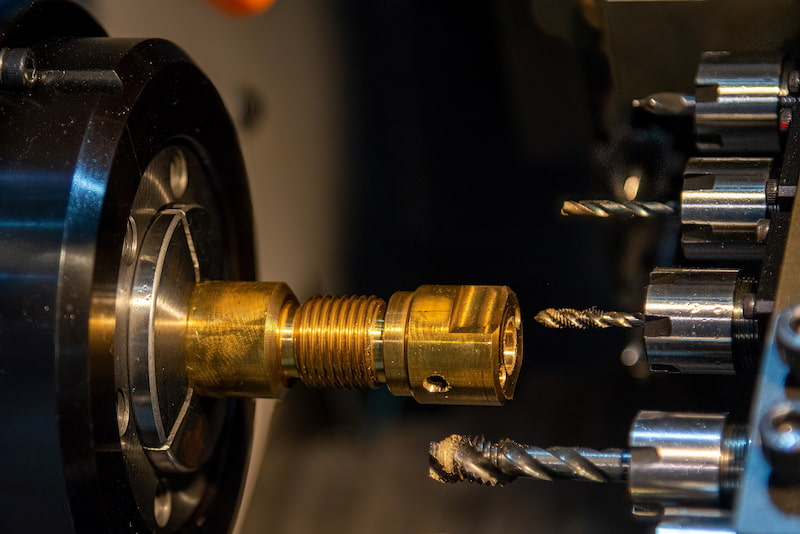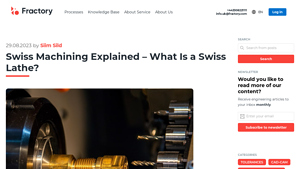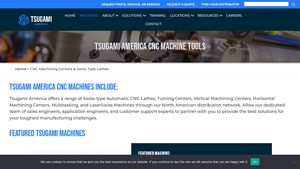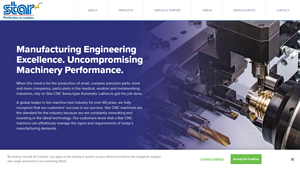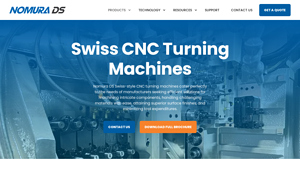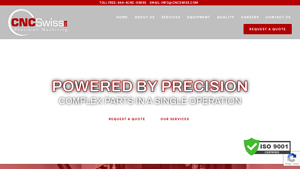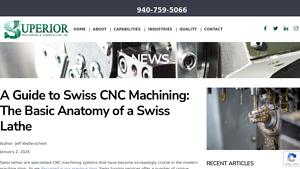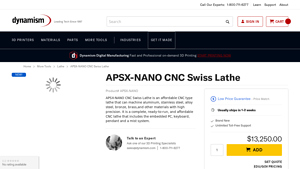Cnc Swiss Turning Guide: Type, Cost, Top List…
Introduction: Navigating the Global Market for cnc swiss turning
In today’s highly competitive global market, sourcing precision-engineered components through CNC Swiss turning can pose significant challenges for B2B buyers, particularly those in emerging economies across Africa, South America, the Middle East, and Europe. The demand for high-quality, intricate parts—ranging from medical devices to aerospace components—requires a comprehensive understanding of the Swiss machining process, supplier capabilities, and cost considerations. This guide aims to demystify CNC Swiss turning by exploring various machine types, their applications, and the critical factors to consider when vetting suppliers.
International B2B buyers will find actionable insights on how to identify reputable manufacturers and navigate the complexities of sourcing. By providing a thorough overview of the benefits of Swiss turning, including its ability to produce components with extremely tight tolerances and shorter cycle times, this guide empowers decision-makers to make informed purchasing choices. Additionally, we delve into the financial implications of investing in Swiss machining technology and offer strategic advice on optimizing procurement processes.
Whether you’re in Saudi Arabia, Vietnam, or anywhere in between, understanding the intricacies of CNC Swiss turning will enhance your ability to procure high-precision parts that meet your operational needs and quality standards. With this resource, you will be equipped to tackle sourcing challenges head-on and leverage the advantages of advanced machining techniques.
Understanding cnc swiss turning Types and Variations
| Type Name | Key Distinguishing Features | Primary B2B Applications | Brief Pros & Cons for Buyers |
|---|---|---|---|
| Standard Swiss Turning | Uses a guide bushing to support long, slender workpieces; excellent for high-volume production. | Medical devices, automotive components, electronics. | Pros: High precision, reduced part deflection. Cons: Limited to smaller part sizes. |
| Sliding Headstock Swiss Turning | Features a movable headstock without a guide bushing; allows for quicker setups. | Shorter components, prototypes, low-volume runs. | Pros: Faster setup times, better concentricity. Cons: Less stability for longer parts. |
| Multi-Spindle Swiss Turning | Utilizes multiple spindles to perform simultaneous operations; maximizes efficiency. | Aerospace, complex assemblies, high-volume production. | Pros: Increased throughput, reduces cycle time. Cons: Higher initial investment and complexity. |
| Sub-spindle Swiss Turning | Incorporates a secondary spindle for additional operations post-cutting; enhances versatility. | Parts requiring secondary operations like drilling or tapping. | Pros: Reduces handling time, improved workflow. Cons: More expensive due to added complexity. |
| CNC Swiss Turning with Live Tooling | Integrates live tooling for milling operations; expands machining capabilities. | Complex geometries, intricate parts in various industries. | Pros: Greater design flexibility, fewer setups. Cons: Potentially higher operational costs. |
What Are the Characteristics of Standard Swiss Turning?
Standard Swiss turning is characterized by its use of a guide bushing that supports the workpiece during machining. This method excels in producing high-volume, high-precision parts, making it ideal for industries like medical devices and automotive components. Buyers should consider the production scale and part size, as this method is best suited for smaller, intricate components. Its ability to maintain tight tolerances while reducing part deflection is a significant advantage.
How Does Sliding Headstock Swiss Turning Differ?
Sliding headstock Swiss turning features a movable headstock that allows for quicker setups and processing of shorter components. This method is particularly advantageous for low-volume runs and prototyping where time efficiency is essential. B2B buyers should evaluate their production needs, as this type offers better concentricity but may compromise stability for longer parts. The flexibility in setup can lead to reduced lead times for short runs.
What Benefits Does Multi-Spindle Swiss Turning Offer?
Multi-spindle Swiss turning employs several spindles to conduct multiple machining operations simultaneously, significantly enhancing production efficiency. This approach is suitable for high-volume applications, especially in sectors like aerospace where complex assemblies are common. Buyers should weigh the initial investment against the potential for increased throughput and reduced cycle times, as the complexity and cost of these machines can be higher.
Why Choose Sub-Spindle Swiss Turning?
Sub-spindle Swiss turning adds a secondary spindle to perform additional operations after the initial cutting, which increases versatility and workflow efficiency. This method is particularly useful for parts that require secondary operations, such as drilling or tapping. For B2B purchasers, the reduction in handling time and improved operational flow are key considerations, although the added complexity can lead to increased costs.
How Does CNC Swiss Turning with Live Tooling Expand Capabilities?
CNC Swiss turning with live tooling integrates milling capabilities into the machining process, allowing for the production of complex geometries and intricate parts. This variation is advantageous for industries that require detailed designs, as it minimizes the need for multiple setups. Buyers should consider the trade-off between flexibility and potential operational costs, as this method can lead to higher expenses but offers significant design advantages.
Key Industrial Applications of cnc swiss turning
| Industry/Sector | Specific Application of cnc swiss turning | Value/Benefit for the Business | Key Sourcing Considerations for this Application |
|---|---|---|---|
| Medical Devices | Production of surgical instruments and implants | High precision and tight tolerances for safety | Compliance with medical standards and certifications |
| Aerospace | Manufacturing of miniature components for aircraft | Lightweight, complex parts that enhance performance | Material quality and traceability |
| Automotive | Production of precision fasteners and connectors | Increased reliability and performance in vehicles | Supplier capabilities in high-volume production |
| Electronics | Fabrication of intricate components for devices | Enhanced functionality and compact designs | Lead times and flexibility in production capacity |
| Oil & Gas | Creation of specialized fittings and valves | Durability and reliability in harsh environments | Expertise in machining exotic materials |
How is CNC Swiss Turning Applied in Medical Devices?
CNC Swiss turning is pivotal in the medical device industry, particularly for producing surgical instruments and implants. These components require extremely high precision and tight tolerances to ensure patient safety and effective functionality. Buyers in this sector must prioritize suppliers who comply with stringent medical standards and possess relevant certifications, such as ISO 13485. Additionally, the ability to provide documentation for traceability and quality assurance is crucial when sourcing from international suppliers, especially in regions like Europe and the Middle East.
What Role Does CNC Swiss Turning Play in Aerospace Manufacturing?
In aerospace, CNC Swiss turning is employed to manufacture miniature components, such as brackets and fasteners, that are critical for aircraft performance. The lightweight and complex geometries achievable through this machining process contribute to overall efficiency and safety. Buyers in this sector should consider suppliers who can demonstrate expertise in working with high-performance materials and can provide detailed documentation for material quality and compliance with aerospace regulations, particularly when sourcing from regions like South America and Africa.
How is CNC Swiss Turning Beneficial for Automotive Applications?
The automotive industry utilizes CNC Swiss turning for the production of precision fasteners and connectors essential for vehicle assembly. The high reliability and performance of these components directly impact vehicle safety and functionality. When sourcing for automotive applications, businesses should seek suppliers that can handle high-volume production while maintaining quality control. Suppliers should also be able to adapt quickly to design changes, which is particularly important in the fast-paced automotive market across Europe and the Middle East.
In What Ways Does CNC Swiss Turning Enhance Electronics Manufacturing?
CNC Swiss turning is integral to the electronics sector, where it fabricates intricate components for various devices, including smartphones and computers. The ability to create compact designs with enhanced functionality is essential in this competitive market. Buyers should focus on sourcing partners who can ensure quick lead times and flexibility in production capacity, accommodating rapid technological advancements and market demands. This is particularly important for international buyers looking to source from regions with varying manufacturing capabilities.
How is CNC Swiss Turning Used in the Oil & Gas Industry?
In the oil and gas sector, CNC Swiss turning is essential for creating specialized fittings and valves that must endure extreme conditions. The durability and reliability of these components are paramount for operational safety and efficiency. Buyers should consider the expertise of suppliers in machining exotic materials, as well as their ability to meet industry-specific standards. Ensuring that suppliers have a proven track record in this field is crucial for international buyers, particularly in regions with challenging operational environments.
3 Common User Pain Points for ‘cnc swiss turning’ & Their Solutions
Scenario 1: Managing Tolerances and Precision Requirements
The Problem: For many B2B buyers, particularly in industries like medical device manufacturing or aerospace, the demand for parts with extremely tight tolerances is a critical requirement. Buyers often face challenges when sourcing CNC Swiss turning services that can consistently meet these precision demands. A single deviation can lead to product failures, increased costs, and potential regulatory issues. Additionally, not all manufacturers have the necessary equipment or expertise to handle complex geometries that require high precision.
The Solution: To address this issue, buyers should conduct thorough research when selecting a CNC Swiss turning provider. Look for manufacturers that explicitly showcase their capabilities in handling tight tolerances and complex parts, ideally through detailed case studies or certifications like ISO 9001. It’s essential to engage in direct discussions with potential suppliers about their machinery—specifically, whether they utilize advanced Swiss lathes with guide bushings that enhance precision. Request samples of previous work that illustrate their ability to meet stringent specifications. Establishing clear communication regarding your requirements and expectations will also foster better outcomes and reduce the likelihood of errors.
Scenario 2: High Production Volume Needs
The Problem: B2B buyers in sectors such as automotive or electronics often require large volumes of small, intricate components. The challenge arises when manufacturers struggle to balance speed and quality, leading to bottlenecks in production. Buyers may find that some CNC Swiss turning services are unable to keep pace with their production demands, resulting in delays that can impact overall project timelines and customer satisfaction.
The Solution: To combat this pain point, buyers should prioritize suppliers that not only demonstrate high-speed machining capabilities but also possess a robust setup for rapid production runs. Look for CNC Swiss turning companies that utilize multi-spindle machines, which can simultaneously produce multiple parts, thereby enhancing throughput. Additionally, inquire about their workflow optimization strategies and automation processes, which can significantly reduce cycle times. Engaging with suppliers that offer ready-to-ship parts can also mitigate delays associated with secondary operations. Finally, establishing long-term contracts with suppliers can ensure a reliable production pipeline that aligns with your volume requirements.
Scenario 3: Cost Management and Material Waste
The Problem: Cost management is a significant concern for B2B buyers, particularly in industries where margins are tight. Many buyers encounter issues with excessive material waste during the CNC Swiss turning process, which not only inflates production costs but also impacts sustainability goals. Additionally, the pricing for high-quality Swiss machining can vary significantly, making it challenging to find a cost-effective solution without compromising on quality.
The Solution: To effectively manage costs, buyers should focus on optimizing their material specifications and engaging in discussions with their machining partner about the most efficient use of materials. This could involve selecting the right type of bar stock that minimizes waste while still meeting performance standards. Furthermore, consider working with suppliers who utilize advanced CNC Swiss turning technology that reduces scrap rates, such as those with precise cutting capabilities and effective tool management systems. Establishing a collaborative relationship with your supplier can lead to better pricing agreements and discounts for larger orders. Lastly, always conduct a cost-benefit analysis when comparing different suppliers to ensure you are getting the best value for your investment without sacrificing quality.
Strategic Material Selection Guide for cnc swiss turning
What are the Key Materials for CNC Swiss Turning?
When selecting materials for CNC Swiss turning, understanding the properties, advantages, and limitations of various materials is crucial for international B2B buyers. This guide analyzes four common materials used in Swiss machining: stainless steel, aluminum, brass, and plastics. Each material has unique characteristics that influence its suitability for different applications.
How Does Stainless Steel Perform in CNC Swiss Turning?
Stainless steel is renowned for its excellent corrosion resistance and durability, making it ideal for applications in medical, aerospace, and automotive industries. Key properties include high tensile strength, temperature resistance, and the ability to maintain structural integrity under pressure.
Pros: Stainless steel offers exceptional durability and longevity, making it suitable for high-stress applications. Its corrosion resistance ensures that parts remain functional in harsh environments.
Cons: However, machining stainless steel can be complex, requiring specialized tools and techniques. The cost of stainless steel is generally higher than other materials, which may impact budget considerations.
Impact on Application: Stainless steel components are compatible with various media, including water, oils, and chemicals, making them versatile for multiple applications.
Considerations for International Buyers: Compliance with international standards such as ASTM and DIN is essential. Buyers in regions like Europe and the Middle East often prefer specific grades of stainless steel, such as 316 or 304, for their superior corrosion resistance.
What Advantages Does Aluminum Offer for CNC Swiss Turning?
Aluminum is lightweight and has excellent machinability, making it a popular choice for industries like electronics and automotive. Key properties include a good strength-to-weight ratio, excellent thermal conductivity, and resistance to corrosion.
Pros: The primary advantage of aluminum is its ease of machining, which leads to lower manufacturing costs and shorter lead times. Its lightweight nature makes it ideal for applications where weight is a critical factor.
Cons: On the downside, aluminum is less durable than stainless steel and can be prone to deformation under high-stress conditions. Its lower melting point also limits its use in high-temperature applications.
Impact on Application: Aluminum is compatible with various media, including water and air, making it suitable for a wide range of applications.
Considerations for International Buyers: Buyers should consider the alloy type, as different grades (e.g., 6061, 7075) offer varying levels of strength and corrosion resistance. Compliance with JIS standards is often preferred in Asian markets.
Why Choose Brass for CNC Swiss Turning?
Brass is commonly used for its excellent machinability and aesthetic appeal, particularly in decorative applications and plumbing fittings. Key properties include good corrosion resistance and electrical conductivity.
Pros: Brass components are easy to machine and can be produced with intricate designs. Its resistance to corrosion makes it suitable for plumbing and electrical applications.
Cons: However, brass is generally more expensive than aluminum and can be less durable in high-stress environments. Its susceptibility to dezincification in certain conditions can also limit its applications.
Impact on Application: Brass is compatible with water and many chemicals, making it a go-to material for plumbing and electrical applications.
Considerations for International Buyers: Buyers should ensure compliance with relevant standards like ASTM B36 for brass, especially in regions like South America and Europe where quality assurance is paramount.
What Role Do Plastics Play in CNC Swiss Turning?
Plastics, such as nylon and polycarbonate, are increasingly used in CNC Swiss turning due to their lightweight and versatile properties. Key characteristics include good chemical resistance and low density.
Pros: The main advantage of plastics is their lightweight nature and resistance to corrosion, which makes them suitable for various applications, including medical devices and consumer products.
Cons: However, plastics can be less durable than metals and may not withstand high temperatures or pressures. Their machining can also be challenging, requiring specific tools and techniques.
Impact on Application: Plastics are compatible with various media, including oils and chemicals, but may not perform well in high-temperature environments.
Considerations for International Buyers: Compliance with international standards, such as ISO 9001 for quality management, is crucial. Buyers should also consider the specific type of plastic and its applications to ensure suitability.
Summary Table of Material Selection for CNC Swiss Turning
| Material | Typical Use Case for cnc swiss turning | Key Advantage | Key Disadvantage/Limitation | Relative Cost (Low/Med/High) |
|---|---|---|---|---|
| Stainless Steel | Medical devices, aerospace components | Excellent corrosion resistance | Higher machining complexity and cost | High |
| Aluminum | Automotive parts, electronics | Lightweight and easy to machine | Less durable under stress | Medium |
| Brass | Plumbing fittings, decorative items | Good machinability and aesthetic appeal | More expensive and less durable | Medium |
| Plastics | Medical devices, consumer products | Lightweight and corrosion-resistant | Less durable and temperature-sensitive | Low |
This strategic material selection guide provides B2B buyers with essential insights into the materials most suitable for CNC Swiss turning, helping them make informed decisions that align with their specific application needs and regional compliance requirements.
In-depth Look: Manufacturing Processes and Quality Assurance for cnc swiss turning
What Are the Key Stages in the Manufacturing Process for CNC Swiss Turning?
CNC Swiss turning is a sophisticated manufacturing process that allows for the production of high-precision components with tight tolerances. Understanding the main stages of this process is crucial for B2B buyers looking to source reliable parts. The typical stages include material preparation, forming, assembly, and finishing.
How Is Material Prepared for CNC Swiss Turning?
Material preparation is the first critical step in CNC Swiss turning. It involves selecting the appropriate bar stock, which is usually made of metals such as carbon steel, stainless steel, or brass, and sometimes plastics. The bar stock is cut to length and inspected to ensure it meets the required specifications.
Proper handling during this stage is essential, as any defects can lead to compromised quality in the final product. Buyers should inquire about the material certification and traceability, ensuring that suppliers source their materials from reputable suppliers.
What Forming Techniques Are Utilized in CNC Swiss Turning?
The forming stage employs advanced CNC Swiss machines that use a guide bushing to support the workpiece closely to the tooling area, minimizing deflection and ensuring high precision. The unique sliding headstock allows for both rotational and linear movements, enabling multiple machining operations to occur simultaneously.
Key techniques in this stage include turning, drilling, and milling, all of which can be performed with remarkable accuracy. The versatility of Swiss machines allows for the production of intricate parts with complex geometries, which is particularly beneficial in industries such as aerospace and medical device manufacturing.
How Is Assembly Handled in CNC Swiss Turning?
In many cases, assembly may not be a separate stage in the CNC Swiss turning process, as parts are often produced as ready-to-ship components. However, if multiple components are involved, the assembly process must ensure that all parts fit together seamlessly.
Buyers should confirm that the supplier has a systematic approach to assembly, including the use of jigs or fixtures to maintain alignment. This is especially vital for components that will be integrated into larger systems, where precision and compatibility are paramount.
What Finishing Techniques Are Common in CNC Swiss Turning?
The finishing stage is crucial for achieving the desired surface quality and dimensional accuracy. Techniques such as deburring, polishing, and coating may be employed to enhance the part’s performance and aesthetic appeal.
Buyers should ensure that suppliers adhere to industry standards for surface finishes, as this can significantly impact the functionality of the final product. Inquire about the types of finishing processes available and their compatibility with specific applications.
What Quality Assurance Measures Are Essential for CNC Swiss Turning?
Quality assurance (QA) is a critical aspect of CNC Swiss turning, ensuring that the produced parts meet stringent specifications and industry standards. B2B buyers should be aware of the various QA measures that suppliers implement throughout the manufacturing process.
Which International Standards Should Be Considered for Quality Control?
International standards, such as ISO 9001, provide a framework for quality management systems and are crucial for ensuring consistent product quality. Additionally, industry-specific certifications, such as CE marking for European markets or API standards for oil and gas applications, can further validate a supplier’s commitment to quality.
Buyers should prioritize suppliers with these certifications, as they reflect adherence to rigorous quality management practices.
What Are the Key Quality Control Checkpoints in CNC Swiss Turning?
Quality control checkpoints should be integrated at various stages of the manufacturing process. These include:
- Incoming Quality Control (IQC): This involves inspecting raw materials upon delivery to verify they meet specified standards.
- In-Process Quality Control (IPQC): During the manufacturing process, regular inspections should be conducted to monitor critical dimensions and tolerances.
- Final Quality Control (FQC): Once the parts are completed, a thorough inspection ensures they meet all specifications before shipping.
Buyers should ask suppliers about their QA processes and how frequently these checkpoints are performed.
Which Testing Methods Are Common in Quality Assurance for CNC Swiss Turning?
Common testing methods in quality assurance include dimensional inspection using calipers and micrometers, visual inspections for surface defects, and functional testing to verify performance under operational conditions.
Non-destructive testing (NDT) methods, such as ultrasonic or X-ray inspections, may also be utilized for critical components, especially in high-stakes industries like aerospace. Buyers should inquire about the specific testing methods employed and their relevance to the intended application.
How Can B2B Buyers Verify Supplier Quality Control Practices?
For B2B buyers, verifying a supplier’s quality control practices is essential to ensure reliable and consistent product quality. Several strategies can be employed:
- Conducting Audits: Periodic audits of suppliers can provide insights into their manufacturing processes and quality control measures. This can be done either in-person or through remote assessments.
- Requesting Quality Reports: Suppliers should provide detailed quality reports that outline inspection results, non-conformance issues, and corrective actions taken. This transparency is crucial for building trust.
- Utilizing Third-Party Inspections: Engaging third-party inspection services can offer an unbiased evaluation of a supplier’s quality control practices. This is particularly beneficial for international buyers who may face language or cultural barriers.
What Are the Quality Control Nuances for International B2B Buyers?
International B2B buyers, particularly from regions like Africa, South America, the Middle East, and Europe, should be aware of specific quality control nuances.
Different markets may have varying regulations and standards, necessitating that suppliers demonstrate compliance with local requirements. Additionally, cultural differences in business practices can impact communication and expectations regarding quality.
Buyers should ensure they understand the local standards and certifications required in their market and communicate these expectations clearly to suppliers. Establishing a robust framework for quality assurance will help mitigate risks and ensure the successful sourcing of CNC Swiss turned parts.
By understanding these key aspects of the manufacturing processes and quality assurance for CNC Swiss turning, B2B buyers can make informed decisions when selecting suppliers, ultimately leading to successful partnerships and high-quality products.
Practical Sourcing Guide: A Step-by-Step Checklist for ‘cnc swiss turning’
In the fast-evolving landscape of precision manufacturing, sourcing CNC Swiss turning services requires a strategic approach to ensure high-quality outputs and reliable partnerships. This guide serves as a comprehensive checklist for B2B buyers, helping you navigate the complexities of procuring CNC Swiss turning services.
Step 1: Define Your Technical Specifications
Understanding your project requirements is crucial before initiating the sourcing process. Clearly outline the materials, dimensions, tolerances, and production volumes you need.
– Material Selection: Consider whether you require metals, plastics, or a combination. Each material will have different machining characteristics and cost implications.
– Complexity of Parts: Specify if you need simple turned components or intricate geometries that demand advanced Swiss machining capabilities.
Step 2: Identify Potential Suppliers
Compile a list of suppliers who specialize in CNC Swiss turning. Look for companies with a proven track record in your industry or region.
– Industry Experience: Focus on suppliers with relevant experience in sectors such as aerospace, medical devices, or automotive, as these often require stringent quality standards.
– Geographical Considerations: Consider local suppliers for faster turnaround times and reduced shipping costs, especially if your operations are based in Africa, South America, the Middle East, or Europe.
Step 3: Evaluate Supplier Capabilities
Assess the technical capabilities of potential suppliers to ensure they can meet your specifications.
– Machinery and Technology: Investigate the types of Swiss machines they operate and their ability to handle specific materials and tolerances.
– Production Capacity: Ensure the supplier can meet your volume requirements without compromising quality or delivery timelines.
Step 4: Verify Quality Assurance Processes
Quality control is paramount in CNC Swiss turning. Confirm that suppliers adhere to industry standards and have robust quality assurance processes in place.
– Certifications: Look for ISO certifications or other industry-specific qualifications that indicate a commitment to quality.
– Inspection Techniques: Inquire about their inspection methods, such as CNC measurement systems or statistical process control, to ensure consistent quality.
Step 5: Request Samples and Prototypes
Before making a significant commitment, request samples or prototypes of the components you need. This step allows you to evaluate the supplier’s capabilities firsthand.
– Functional Testing: Assess the samples for adherence to your specifications and functional performance.
– Feedback Loop: Use this opportunity to communicate any necessary adjustments and gauge the supplier’s responsiveness to feedback.
Step 6: Understand Pricing Structures
Pricing can vary significantly based on complexity, materials, and production volume. Engage in transparent discussions regarding costs.
– Cost Breakdown: Request a detailed cost breakdown that includes machining, material, finishing, and shipping to avoid hidden fees.
– Negotiation Opportunities: Explore bulk pricing or long-term contract options that might offer better rates.
Step 7: Establish Clear Communication Channels
Effective communication is vital for a successful partnership. Establish clear lines of communication with your chosen supplier.
– Regular Updates: Set expectations for regular updates on production status, especially for larger or time-sensitive projects.
– Point of Contact: Designate a primary contact person on both sides to streamline communication and resolve any issues that may arise promptly.
By following these steps, B2B buyers can ensure a more efficient and successful sourcing process for CNC Swiss turning services, ultimately leading to high-quality components and a strong supplier relationship.
Comprehensive Cost and Pricing Analysis for cnc swiss turning Sourcing
What Are the Key Cost Components in CNC Swiss Turning?
When evaluating the costs associated with CNC Swiss turning, several key components must be considered. The primary cost factors include:
-
Materials: The choice of raw materials significantly impacts overall costs. Common materials used in Swiss machining include metals such as carbon steel, aluminum, stainless steel, and brass, as well as some plastics. The material’s price can fluctuate based on market conditions, availability, and specific material properties required for the project.
-
Labor: Skilled labor is essential for operating CNC Swiss machines. Labor costs vary by region and the level of expertise required. In regions such as Africa and South America, labor may be less expensive, but the availability of skilled machinists can affect productivity and quality.
-
Manufacturing Overhead: This includes costs related to the facility, utilities, equipment maintenance, and administrative expenses. Overhead can vary widely among suppliers based on their operational efficiency and location.
-
Tooling: Specialized tooling is necessary for Swiss machining, and these costs can add up depending on the complexity of the parts being produced. Custom tooling may be required for unique specifications, which can further increase costs.
-
Quality Control (QC): Implementing rigorous QC processes ensures that parts meet specified tolerances and quality standards. The cost of QC varies based on the complexity of the inspection required, including the technology used for measurement and testing.
-
Logistics: Transportation and shipping costs can fluctuate significantly based on the distance between the supplier and the buyer, as well as the chosen Incoterms. International buyers must account for customs duties and tariffs, which can also influence total costs.
-
Margin: Suppliers will typically include a profit margin in their pricing, which can vary based on market competition, demand, and the supplier’s business model.
How Do Price Influencers Impact CNC Swiss Turning Costs?
Several factors can influence the pricing of CNC Swiss turning services:
-
Volume and Minimum Order Quantity (MOQ): Higher order volumes often lead to lower per-unit costs due to economies of scale. Conversely, low-volume orders may incur higher costs due to the need for setup and tooling.
-
Specifications and Customization: Customized parts with intricate specifications will generally cost more than standard components. The complexity of the design affects machining time and tooling requirements.
-
Materials: Different materials have varying costs, and specialty alloys or high-performance plastics can significantly increase the overall price. Buyers should evaluate the material’s properties against their application needs to ensure cost-effectiveness.
-
Quality and Certifications: Parts requiring stringent quality standards or industry certifications (e.g., ISO, AS9100) may have higher prices due to additional QC measures and documentation.
-
Supplier Factors: The supplier’s reputation, capabilities, and location can also affect pricing. Established suppliers with advanced machinery and skilled labor may charge a premium but can offer better reliability and faster turnaround times.
-
Incoterms: The choice of Incoterms affects shipping responsibilities, risk, and costs. Understanding which party is responsible for freight, insurance, and customs can lead to better cost management.
What Are Effective Buyer Tips for CNC Swiss Turning Sourcing?
For international B2B buyers, particularly from regions such as Africa, South America, the Middle East, and Europe, navigating the complexities of CNC Swiss turning sourcing requires strategic insights:
-
Negotiate Terms: Engage in open discussions with suppliers about pricing, payment terms, and lead times. Consider leveraging volume commitments to secure better pricing.
-
Focus on Cost-Efficiency: Assess the Total Cost of Ownership (TCO) rather than just the unit price. This includes considering the long-term benefits of quality parts, reduced rework, and reliability.
-
Understand Pricing Nuances: Familiarize yourself with the local market conditions affecting material costs and labor rates. Prices can vary significantly based on regional economic factors, so it’s essential to conduct thorough market research.
-
Seek Multiple Quotes: Obtain quotes from multiple suppliers to compare pricing and services. This not only helps in identifying competitive pricing but also provides insights into the market.
-
Evaluate Supplier Capabilities: Prioritize suppliers with proven expertise in CNC Swiss turning. A supplier’s ability to meet your specifications and deliver on time can justify a higher price point.
Disclaimer
Prices for CNC Swiss turning services can fluctuate based on market conditions, supplier capabilities, and specific project requirements. Buyers should conduct thorough due diligence and obtain multiple quotes to ensure they are getting the best value for their investment.
Alternatives Analysis: Comparing cnc swiss turning With Other Solutions
Introduction: Exploring Alternatives to CNC Swiss Turning
When considering manufacturing methods for high-precision parts, CNC Swiss turning is often a top choice due to its exceptional accuracy and efficiency. However, it’s essential for B2B buyers to evaluate alternative solutions that may also meet their production needs. This analysis will compare CNC Swiss turning with two viable alternatives: conventional CNC turning and multi-tasking machining centers. Each method has its unique advantages and limitations that can impact decision-making for international buyers.
Comparison Table
| Comparison Aspect | Cnc Swiss Turning | Conventional CNC Turning | Multi-Tasking Machining Centers |
|---|---|---|---|
| Performance | High precision, tight tolerances, fast cycle times | Moderate precision, slower cycle times | High versatility, multiple operations in one setup |
| Cost | Higher initial investment, lower operational costs | Lower initial investment, higher operational costs | High initial investment, potential cost savings through reduced setups |
| Ease of Implementation | Requires skilled operators, setup can be complex | Easier for operators familiar with traditional lathes | Complex setup, requires skilled personnel |
| Maintenance | Generally low, but requires specialized knowledge | Moderate, easier to find service providers | High maintenance due to complexity, specialized service may be needed |
| Best Use Case | High-volume production of small, intricate parts | Larger parts with simpler geometries | Complex parts requiring multiple operations, low to medium volumes |
Detailed Breakdown of Alternatives
Conventional CNC Turning
Conventional CNC turning machines are well-established in the manufacturing sector and can produce a wide range of parts. They typically operate with a fixed headstock and can handle larger workpieces, making them suitable for more straightforward geometries. The initial investment for conventional lathes is often lower than for Swiss machines, making them accessible for smaller operations. However, they generally have longer cycle times and may not achieve the same level of precision as Swiss turning, especially for small, intricate components. Buyers seeking versatility for larger or less complex parts may find conventional CNC turning a viable option.
Multi-Tasking Machining Centers
Multi-tasking machining centers combine turning, milling, and other operations in a single setup. This integration can significantly reduce production time and improve efficiency, making them ideal for complex parts that require multiple operations. Although the initial investment is high, these centers can offer substantial savings in the long run by minimizing setup times and labor costs. However, the complexity of these machines may require highly skilled operators and specialized maintenance, which can be a barrier for some manufacturers. Businesses focused on producing intricate parts with varying geometries may benefit from considering this option.
Conclusion: How to Choose the Right Solution for Your Needs
Selecting the most suitable machining solution depends on several factors, including production volume, part complexity, and budget constraints. CNC Swiss turning is unparalleled for high-volume production of small, precise components. In contrast, conventional CNC turning may be better suited for larger, simpler parts, while multi-tasking machining centers excel in versatility and efficiency for complex geometries. B2B buyers should carefully assess their specific requirements, including operational capabilities and long-term costs, to make an informed decision that aligns with their manufacturing goals.
Essential Technical Properties and Trade Terminology for cnc swiss turning
What Are the Key Technical Properties of CNC Swiss Turning?
When considering CNC Swiss turning for your manufacturing needs, understanding the technical properties is essential for ensuring quality and efficiency. Here are some critical specifications that impact the production process and product quality:
1. Material Grade
CNC Swiss turning can accommodate a range of materials, including metals like stainless steel, aluminum, and brass, as well as plastics. The choice of material affects not only the durability and functionality of the part but also its machinability. For B2B buyers, selecting the right material grade is vital for meeting industry standards and ensuring the end product’s performance in its application.
2. Tolerance
Swiss turning machines excel in achieving extremely tight tolerances, often within ±0.001 inches. This precision is crucial for applications in sectors like aerospace and medical devices, where even minor deviations can lead to significant issues. Understanding tolerance requirements helps buyers specify their needs clearly and ensures that suppliers can meet quality expectations.
3. Length-to-Diameter Ratio
Swiss lathes are particularly effective for parts with high length-to-diameter ratios, often exceeding 4:1. This capability allows for the production of long, slender components without compromising precision. For B2B buyers, knowing the length-to-diameter ratio helps in selecting the right machining process and equipment for specific applications.
4. Cycle Time
Cycle time refers to the duration it takes to complete a machining operation. Swiss lathes can significantly reduce cycle times due to their ability to perform multiple operations simultaneously. For businesses, shorter cycle times mean increased productivity and lower manufacturing costs, making it a critical factor in decision-making.
5. Surface Finish
The surface finish produced by Swiss turning is typically superior to that achieved by conventional machining processes. This quality can reduce or eliminate the need for secondary operations, such as polishing or coating. For buyers, understanding the expected surface finish is essential for ensuring that the final product meets aesthetic and functional requirements.
What Are Common Trade Terms in CNC Swiss Turning?
Familiarizing yourself with industry jargon can enhance communication with suppliers and streamline the procurement process. Here are some commonly used terms in the CNC Swiss turning industry:
1. OEM (Original Equipment Manufacturer)
An OEM refers to a company that produces parts or equipment that are used in another company’s end product. In the context of CNC Swiss turning, buyers often engage with OEMs to source precision components. Understanding the OEM landscape helps businesses identify reliable partners for their manufacturing needs.
2. MOQ (Minimum Order Quantity)
MOQ is the smallest quantity of a product that a supplier is willing to sell. In CNC Swiss turning, MOQs can vary based on the complexity of the part and the supplier’s capabilities. For buyers, knowing the MOQ is essential for budgeting and planning production runs.
3. RFQ (Request for Quotation)
An RFQ is a document sent to suppliers requesting pricing and terms for specific products or services. In the CNC Swiss turning industry, RFQs help buyers obtain competitive pricing and ensure that suppliers understand the technical specifications required. A well-prepared RFQ can streamline the procurement process and lead to better supplier relationships.
4. Incoterms
Incoterms (International Commercial Terms) are a set of predefined international trade terms that clarify the responsibilities of buyers and sellers in a transaction. Understanding Incoterms is crucial for B2B buyers as they dictate shipping costs, risk, and responsibility for goods in transit, impacting overall project budgets and timelines.
5. Lead Time
Lead time is the amount of time it takes from placing an order to receiving the finished product. In CNC Swiss turning, lead times can vary based on production schedules and material availability. For businesses, understanding lead times is essential for inventory management and ensuring timely project completion.
By grasping these technical properties and trade terms, B2B buyers can make more informed decisions in their CNC Swiss turning projects, ultimately leading to better outcomes and stronger supplier partnerships.
Navigating Market Dynamics and Sourcing Trends in the cnc swiss turning Sector
What Are the Current Market Dynamics and Key Trends in the CNC Swiss Turning Sector?
The CNC Swiss turning sector is witnessing significant growth driven by the increasing demand for precision-engineered components across various industries, including aerospace, automotive, and medical. The global shift toward automation and advanced manufacturing technologies is enabling suppliers to enhance production efficiency and reduce lead times. Emerging technologies such as Industry 4.0, which integrates IoT and AI into manufacturing processes, are also reshaping sourcing strategies for international B2B buyers. Companies are increasingly investing in smart machinery that can monitor performance in real-time and predict maintenance needs, thereby minimizing downtime.
Additionally, the trend toward customization is gaining traction, with buyers seeking suppliers capable of delivering tailored solutions that meet specific design requirements. This is particularly important in regions like Africa and South America, where local manufacturing capabilities are expanding, creating opportunities for regional suppliers. Moreover, the focus on supply chain transparency is becoming critical. Buyers are now prioritizing suppliers that can provide clear documentation and traceability of materials used in CNC Swiss turning, ensuring compliance with international standards.
How Are Sustainability and Ethical Sourcing Shaping the CNC Swiss Turning Market?
Sustainability and ethical sourcing are increasingly influencing purchasing decisions in the CNC Swiss turning market. Environmental impacts associated with machining processes, such as waste generation and energy consumption, are prompting buyers to seek manufacturers that adopt greener practices. For instance, suppliers that utilize eco-friendly lubricants and cutting fluids, along with energy-efficient machinery, can significantly reduce their carbon footprint.
The importance of ethical supply chains is also on the rise. B2B buyers are more inclined to partner with suppliers that demonstrate a commitment to social responsibility, including fair labor practices and community engagement. Certifications such as ISO 14001 for environmental management and ISO 45001 for occupational health and safety are becoming essential for suppliers looking to gain a competitive edge. Furthermore, sourcing materials that are recycled or sustainably produced is becoming a key consideration for buyers committed to reducing their environmental impact.
What Is the Brief History and Evolution of CNC Swiss Turning for B2B Buyers?
CNC Swiss turning originated in the late 19th century with the invention of the Swiss-style lathe by Jakob Schweizer, designed specifically for the watchmaking industry. Its ability to produce small, intricate parts with high precision revolutionized manufacturing, setting a standard that would later be adopted across various sectors. By the 1960s, the technology gained popularity beyond watchmaking, as industries recognized its efficiency and accuracy for producing complex components.
Over the decades, advancements in CNC technology have further enhanced the capabilities of Swiss lathes, allowing for multi-tasking operations and greater automation. This evolution has made CNC Swiss turning an essential process for manufacturers seeking to meet the growing demands for precision and volume in today’s competitive market. For B2B buyers, understanding this historical context can inform sourcing decisions, as it highlights the technological advancements that have shaped the current landscape of CNC Swiss turning.
Frequently Asked Questions (FAQs) for B2B Buyers of cnc swiss turning
-
How do I choose the right CNC Swiss turning supplier for my business needs?
Choosing the right supplier involves evaluating their experience, capabilities, and reliability. Look for suppliers with a proven track record in precision machining and positive customer reviews. Verify their quality certifications, such as ISO 9001, and inquire about their machinery and technology. It’s also wise to request samples of their previous work and assess their production capacity to ensure they can meet your specific demands. -
What materials can be machined using CNC Swiss turning?
CNC Swiss turning is versatile and can handle a variety of materials, including metals like stainless steel, aluminum, brass, and carbon steel. Some suppliers also work with plastics such as nylon and polycarbonate. The choice of material often depends on the intended application and the specific properties required, such as strength, weight, and corrosion resistance. -
What are the typical minimum order quantities (MOQ) for CNC Swiss turning services?
Minimum order quantities can vary significantly among suppliers, often depending on the complexity of the parts and production capacity. Typically, MOQs can range from 100 to 1,000 units. Discussing your specific project requirements with potential suppliers will help clarify their MOQ policies and whether they can accommodate smaller orders for prototypes or initial runs. -
What payment terms should I expect when sourcing CNC Swiss turning services internationally?
Payment terms can vary widely depending on the supplier and the nature of your agreement. Common arrangements include upfront deposits (20-50%) with the balance due upon completion or shipment of the order. It’s crucial to negotiate terms that suit your cash flow needs while ensuring the supplier is protected. Explore options like letters of credit for larger transactions to mitigate risk. -
How can I ensure quality assurance in CNC Swiss turning production?
Quality assurance can be ensured through rigorous supplier vetting and ongoing communication. Inquire about the supplier’s quality control processes, including in-process inspections and final product testing. Request documentation of their quality certifications and consider implementing periodic audits or visits to their facility. Establishing clear specifications and tolerances upfront will also help maintain quality throughout the production process. -
What logistics considerations should I be aware of when sourcing CNC Swiss turning parts?
Logistics play a vital role in sourcing CNC Swiss turning parts, particularly in terms of shipping methods, delivery times, and costs. Discuss potential shipping options with your supplier, such as air freight for faster delivery or sea freight for cost-effectiveness. Additionally, consider customs regulations and duties in your country, as these can impact lead times and overall costs. -
Can I customize my CNC Swiss turning parts to meet specific design requirements?
Yes, CNC Swiss turning offers significant customization capabilities. Most suppliers can work with your design specifications to produce parts tailored to your needs. Providing detailed CAD drawings or prototypes will facilitate better communication and understanding of your requirements. Discuss any specific features, tolerances, or finishes you require to ensure your expectations are met. -
What industries commonly utilize CNC Swiss turning services?
CNC Swiss turning is widely used in various industries, including aerospace, automotive, medical devices, and electronics. Its ability to produce high-precision and complex components makes it ideal for applications such as connectors, valves, and precision instruments. Understanding the supplier’s experience in your industry can help ensure they are well-equipped to meet your specific needs and standards.
Important Disclaimer & Terms of Use
⚠️ Important Disclaimer
The information provided in this guide, including content regarding manufacturers, technical specifications, and market analysis, is for informational and educational purposes only. It does not constitute professional procurement advice, financial advice, or legal advice.
While we have made every effort to ensure the accuracy and timeliness of the information, we are not responsible for any errors, omissions, or outdated information. Market conditions, company details, and technical standards are subject to change.
B2B buyers must conduct their own independent and thorough due diligence before making any purchasing decisions. This includes contacting suppliers directly, verifying certifications, requesting samples, and seeking professional consultation. The risk of relying on any information in this guide is borne solely by the reader.
Top 8 Cnc Swiss Turning Manufacturers & Suppliers List
1. Fractory – Precision Swiss Machining
Domain: fractory.com
Registered: 2000 (25 years)
Introduction: Swiss machining, also known as Swiss turning, is a high-precision CNC machining process performed on Swiss lathes designed for small and intricate parts. Key features include:
– Operates with small tolerances and shorter cycle times than conventional lathes.
– Originally designed for the watchmaking industry.
– Uses a sliding headstock and guide bushing for improved accuracy and reduced part de…
2. Tsugami America – CNC Machines
Domain: tsugamiamerica.com
Registered: 2020 (5 years)
Introduction: Tsugami America offers a range of CNC machines including Swiss-type Automatic CNC Lathes, Turning Centers, Vertical Machining Centers, Horizontal Machining Centers, Multitasking, and LaserSwiss Machines. Featured machines include: 1. M08SY – Turning Center with Y-Axis: Performs turning, drilling, boring, cross-drilling, and CNC milling with built-in spindles for reduced vibration. 2. TMA8F – 65 mm…
3. Star CNC – Swiss-type Automatic Lathes
Domain: starcnc.com
Registered: 1997 (28 years)
Introduction: This company, Star CNC – Swiss-type Automatic Lathes, is a notable entity in the market. For specific product details, it is recommended to visit their website directly.
4. Reddit – CNC Swiss Machine
Domain: reddit.com
Registered: 2005 (20 years)
Introduction: CNC Swiss Machine: Moves the work in relation to a stationary tool, typically features a guide bushing, ganging tools, and is designed for small diameter workpieces. Known for high precision and stability, especially for long slender parts. Commonly used for parts less than 50 thou in diameter and up to 30X Length to Diameter ratio.
Lathe with Live Tooling: A conventional lathe that has powered …
5. Nomura DS – Swiss-style CNC Turning Machines
Domain: nomura-ds.com
Registered: 2023 (2 years)
Introduction: Nomura DS Swiss-style CNC turning machines are designed for manufacturers seeking efficient solutions for machining intricate components. They handle challenging materials, achieve superior surface finishes, and minimize tool expenditures. The product series includes DB Series, J Series, KM Series, SB Series, UB Series, and X Series, with maximum machining diameters ranging from 10mm to 42mm. Key …
6. CNC Swiss Inc. – Precision Swiss Machining and CNC Turning Services
Domain: cncswiss.com
Registered: 2011 (14 years)
Introduction: CNC Swiss Inc. specializes in precision Swiss machining and CNC turning services. Key product details include:
– Facility Size: 30,000 sq ft
– OD Capacity: up to 2″ (51mm)
– Accuracy: capable within +/-.0001″
– Quality Certifications: ISO 9001:2015 Certified
– Quality Control Features: Continuous quality control program, High QA Quality Software System, QMS integrated with ProShop ERP, Quality Con…
7. Superior Machining – Swiss Lathes
Domain: superior-machining.net
Registered: 2004 (21 years)
Introduction: Swiss lathes are specialized CNC machining systems that utilize a main spindle for high-speed rotation (100 to 10,000 rpm), a tool headstock with multi-tool stations, a sliding guide bushing for support and precision, a cross-slide for lateral movement of cutting tools, a turret for quick tool change-outs, a sub-spindle for simultaneous machining, an automatic bar feeder for continuous operation, …
8. APSX – APSX-NANO CNC Swiss Lathe
Domain: dynamism.com
Registered: 1997 (28 years)
Introduction: Product Name: APSX-NANO CNC Swiss Lathe
Product Number: APSX-NANO
Price: $13,250.00
Shipping: Usually ships in 1-2 weeks
Weight: Approximate weight: 150 lbs
Power Requirement: 120V standard wall outlet with proper grounding
Dimensions: Machine base footprint: 31″ x 14″; Required space: 40” x 22”
Materials Machined: Aluminum, Stainless Steel, Alloy Steel, Titanium (Grade 5), Bronze, Brass, Delrin (…
Strategic Sourcing Conclusion and Outlook for cnc swiss turning
In the rapidly evolving landscape of precision manufacturing, CNC Swiss turning stands out as a pivotal technology for producing intricate components with exceptional accuracy and efficiency. As highlighted, the advantages of Swiss machining—such as the ability to achieve tight tolerances, reduce cycle times, and manufacture complex parts—position it as an essential solution for diverse industries ranging from medical devices to aerospace components.
Strategic sourcing in CNC Swiss turning not only facilitates access to cutting-edge technology but also ensures that international B2B buyers can engage with reliable suppliers who understand the nuances of their specific market needs. By leveraging global partnerships, businesses can enhance their supply chains, reduce production costs, and optimize operational efficiency.
Looking ahead, the demand for high-precision manufacturing is set to grow, particularly in emerging markets across Africa, South America, the Middle East, and Europe. To remain competitive, it is imperative for B2B buyers in these regions to actively explore partnerships with Swiss turning specialists. By investing in strategic sourcing initiatives today, companies can secure a competitive advantage and drive innovation in their respective sectors. Engage with suppliers who prioritize quality and precision to ensure your manufacturing processes are equipped for the future.

